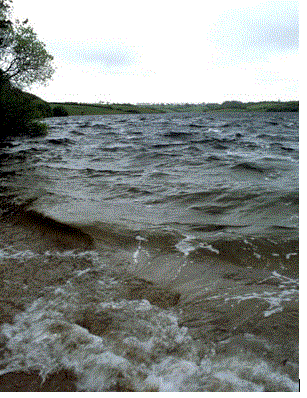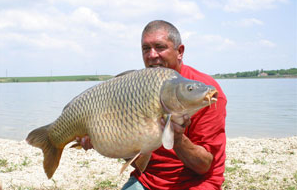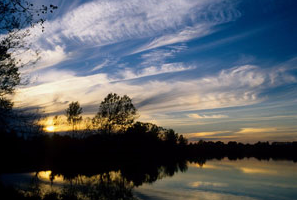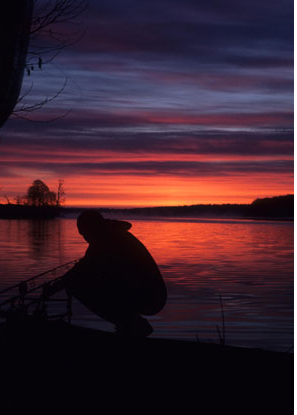Wednesday, 8th August 2012
I want to deviate slightly from my usually subject matter this month and next in order to deal with a subject that seems to crop up regularly on the carp fishing forums; namely, the effect that wind strength and direction is likely to have on the fishing. To be honest I don’t think that there is a single definitive solution as waters react very differently to one another, even when subjected to identical conditions. You may fish a lake where the fish respond positively to a fresh wet breeze, while the same conditions on another lake such weather will not affect the fishing at all.
Like so much in carp fishing it is impossible to set hard and fast rules, but you can lay down general guidelines that will help you to assess a given situation. However, at the end of the day, experience is what counts; the experience of fishing many different venues, and the experience of realising that the guidelines are just that, and that they don’t hold true everywhere you fish.
One of the most commonly voiced pieces of dogma is that you should follow the wind. According to virtually every expert, writer or opinion maker, this is the sure fire way to get among the carp…but is it? While it is true that the wind plays a significant part in modern day carp fishing, it is not always the case that the wind will invariably influence the fish. The phrase “to follow the wind” means that you will be fishing with the wind in your face or into an area where a strong wind is blowing. The reasoning behind this is that you feel that the carp will follow the wind until they arrive at the place where the waves hit the shoreline. Here the water will be affected by wave action, as the turbulence from the breaking waves will greatly increase the amount of oxygen where the water is churned up.
If the wind is fierce the wave effect becomes more pronounced and an undertow is created by the pounding waves that can stretch back out into the lake by fifty or even sixty yards. The distance the undertow extends out from the windward bank will depend on the depth of the water. On lakes with deep margins the discolouration caused by the undertow tends to sink downwards rather than extend away from the bank. On shallower lakes the dirty water has nowhere to go but out from the bank. This undertow of coloured, food-rich water will have a generally beneficial effect on the fish, as it will be rich with disturbed natural food items and very well oxygenated. These are ideal conditions in which to fish a mass bat approach using, say, hempseed, groats or Red Band. Carp are less aware of the possibility of danger in these turbulent conditions and they feed more confidently and aggressively and a mass bait only serves to encourage this type of feeding still further.
The photo of my swim at Lake Sarulesti in Romania illustrates perfectly my point about the wave action and undertow. You can see from the waves that it is blowing hard right into the beach-like swim and you can also see the large area of coloured water stirred up by the waves. While the coloured water does not extend out more than about thirty meters from the bank the undertow nevertheless exists, and in this case it extends downwards rather than outwards due the very deep margins, which drop down to about 25 feet. However, the area of dirty water covers a very wide area, extending as it does along the bank for some distance.
Prior to the wind picking up, the lake had been white calm, as you can see behind me in the photo of the big common. This fish was hooked at extreme range on a plateau some 250m out from the bank and while the weather remained settled that was the only place I could get a pick up. However, once the wind picked up and started blowing hard the fish came right into the edge and they could be caught just a short lob out. Indeed, we were baiting up with a spod and a throwing stick at no more than twenty to thirty meters out, yet the fish fed like crazy in the dirty water.
So, there will be times when the carp certainly do go mad on a big wind and you can really bag up. However, I have experienced plenty of occasions when I sat there with half a gale punching into my face, waiting for fish that never turned up!
Anglers themselves can play a major part in affecting the behaviour of carp, often to the extent that they will defiantly refuse to follow a new or strengthening wind. As carp fishing becomes ever more popular there are signs than on some of the most hard-fished lakes the fish have started to rebel against their instincts and ignore the influence of the wind. Why? Simply because the carp know that there will be anglers waiting for them when they arrive at the windward end of the lake.
For many years I fished a College Reservoir in Cornwall. The lake lies close to the Atlantic Ocean and it is strongly affected by the weather, particularly by the prevailing south westerly wind. This blows up the lake away from two large islands situated in the southern end of the lake. For many years the carp would follow a fresh south or south west wind at the drop of a hat, even the merest zephyr of wind being enough to push them up towards the North Bay and on a big southerly blow the North Bay was the place to fish. However, angler pressure inevitably started to have an influence on the carp and as more people began fishing the lake so the carp increasingly showed signs of ignoring the influence of the wind.
You should also consider the actual temperature of the wind and also the time of year. A north wind in high summer is a very different prospect to one blowing across the lake in the depths of winter. Similarly, while a south west wind will probably be wet and comparatively warm in the summer, the same cannot be said of the winter months. In fact I would go so far as to suggest and in summer south or southwest winds are feeding winds they are seldom so in winter.
To put it in a nutshell, I believe I stand more chance of catching in winter if there is no wind whatsoever. Why? Because when it’s white calm the sun will have more of an influence than the wind, as it will have a warming effect even on the shortest day. In addition the lack of wave action means that there will be little or no stirring of the water, something that tends to mix warmer and colder layers of water together. In these kinds of conditions I would make a beeline for the shallowest part of the lake, especially if it lay on the west bank. Here the lake water will be warmer, maybe only a couple of degrees or so, but it will usually be enough to trigger a brief feeding spell.
Water temperature will also be a major contributing factor. Fish are far less likely to move on a cold north or north easterly breeze than they are on a warm south or southwest wind. This is even more of a factor in the winter when I have found that fish are reluctant to move on any wind, regardless of its direction. I realise that I am flying in the face of a great deal of accepted wisdom here but in winter the strength and direction of the wind does not figure in my choice of swim as I feel that there are more important factors to take into consideration.
All in all this is a complex subject that cannot be classified in terms of ‘correct’ or ‘incorrect’ procedure. In fact there are so many shades of grey that it’s not really possible to give definitive answers. The thing is, carp are anything but predictable and, as is the case with much of fishing, the influence the weather has on our sport is something of an unknown quantity, and sometime you need nothing more than a good dose of luck!

While it is true that the wind plays a significant part in modern day carp fishing, it is not always the case that the wind will invariably influence the fish.

During the warmer months of the year it’s a safe bet to follow the wind.

During the coldest months of the year the opposite applies! I prefer flat calms.

Look at the dirty water stirred up by wave action at Sarulesti.

Conditions like the above are perfect for fishing a mass bait approach.

A nice Sarulesti common caught before the storm when the fish were 250m out on a plateau.

Mackerel Skies like this indicate a big blow on the way.

A red sky in the morning, invariably heralds the arrival of wind and rain.

This 36lb mirror from the Chateau Lake was caught in December in flat calm conditions after a cloudless, windless day.
Written by Ken Townley


